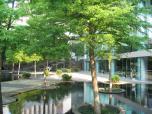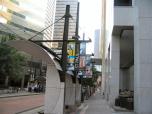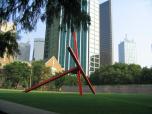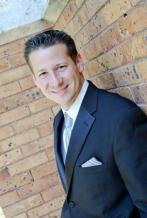




Jason Mellard, an Emerging Leader with AIA Dallas, just completed a busy year with involvement in several interesting projects, serving in the community and getting married in May. I caught up with this talented young architect over lunch near his office at Dallas-based Corgan recently. He shared his perspectives on good design and how it can be used to enhance the quality of life for all citizens in the urban community. We discussed some of his interesting creations which can be viewed here.
Chuck: Jason, you have lived in Oak Lawn, the M Streets, and now North Oak Cliff in Dallas. What attracts you to living in these urban neighborhoods?
Jason: I like to see evidence of change over time. A good mix of cultures and income levels can produce diversity leading to creative expression. It has been great to see public art installed on Henderson Ave and new galleries opening up in North Oak Cliff.
Chuck: Why did you want to become an architect?
Jason: I wanted to be in a field where I was constantly learning and open to new ideas. I wanted to be exposed to different ways of looking at the world, and be able to create something tangible having a lasting impact on the community.
Chuck: What would you say are your design values?
Jason: A building needs to be something people can relate to – whether it speaks to its surrounding community, culture, or history, or helps the user to see things in a different way. The building should stimulate the senses so that when the user comes away from experiencing a structure he has learned something or been changed in some way, having his eyes opened up more to the world around him.
Chuck: What place or places in Dallas best reflect your values of good design?
Jason: The new series of Lake Flato buildings at the Dallas Arboretum, as well as the Nasher Sculpture Center. The buildings and gardens blend the inside with the outside. They are tactile, tell a story and heighten your awareness of nature. Other places I like are Henderson Avenue, the Bishop Arts District, and Highland Park Village where there is a greater density of small shops that evolve over time. These spaces encourage social interaction, and promote people being outdoors, experiencing a blend of art, architecture, retail and dining.
Chuck: As Americans really appreciate freedom of choice in society, how can a building be designed to reflect unique individual tastes while also contributing to the greater good of a city?
Jason: Few buildings deserve to stand alone as isolated jewels. Most buildings should fit in with their surroundings, taking into account history, unique constraints, cultures, and aesthetics. It’s fine for them to be unique, but they need to be an asset to their surroundings and not a detriment.
Chuck: As you look at Dallas what do you see to be its greatest design need?
Jason: Downtown is improving, where a clear urban and social core is developing in the evolution of the Main Street Corridor with its new parks and restaurants and multi-use renovations, etc… But, on a larger scale, Dallas needs more pedestrian connections, walkable communities and sustainable design.
Chuck: What do you perceive to be Dallas’ and possibly other cities’ greatest social needs?
Jason: I would say providing respectable housing and livable communities for low income residents.
Chuck: Housing in convenient quality areas of cities can be prohibitively expensive. How can the design community contribute to greater opportunities in housing choice for low to moderate income persons while still respecting that housing opportunities are driven by economics?
Jason: The West Dallas Planning District across the Margaret Hunt Hill bridge has been master planned to keep the La Bajada neighborhood intact while encouraging the neighborhood to improve along with the future growth of the master plan. AIA Dallas surveyed residents in La Bajada, and the Dallas City Design studio worked closely with planners and officials to respect and protect the neighborhood with its diverse cultures and history for the future. It takes collaboration between many partners plus participation by residents and users themselves to bring about lasting change.
Chuck: How can good design in an urban area address our cities’ greatest social needs?
Jason: Good design should welcome all races and classes to interact with it. Design of good spaces should incorporate elements of delight.
Chuck: How have you contributed to the urban area of Dallas being a greater place to live?
Jason: I had the opportunity to be involved with the Adamson High School redevelopment project which involved the creation of a new high school designed to current education and technology standards. This design creates a master plan which incorporates ball fields, open plazas, and the existing historic school to revive and refresh the urban landscape.
Chuck: What architectural project have you been involved with that fills you with the most pride?
Jason: I worked on a math and science elementary academy in Tyler Texas, which incorporated special needs students. We provided interactive educational opportunities throughout the building. These included a domed constellation ceiling, sloped wood classroom ceilings, abundant natural light, an experiential outdoor courtyard with raised planting beds, a life-size xylophone, an outdoor classroom and adjacent equine therapy horse arena. This school incorporated many aspect of design that I value.
Chuck: What do you enjoy doing when you are not practicing architecture?
Jason: I like to spend time with my wife, sculpting with wood and metal, mountain biking, and reading.
Chuck: What are your top three goals for the next five years?
Jason: First, I would like to become a better leader of my family. Second, continue to develop as an architect to create more sustainable and engaging buildings as well as fostering greater community and collaboration within the design team. Third, I would like to continue serving the community through volunteer activities and relationships with people in Dallas who are in need. Currently, I mentor a high school student in West Dallas, and have worked with Mercy Street in West Dallas, assisting them with development of their athletic ball field master plan.
Chuck: If there is a legacy you would like to leave as an architect, what would it be?
Jason: To be an architect who always kept the end user in mind and designed buildings and urban spaces that have a lasting, positive impact on the community, enriching peoples’ lives, and helping them see outside of themselves.
Chuck: When people speak about you how would you like for them to describe you as a person?
Jason: Humble, creative, God-fearing, and open
Chuck: How does the Mellard family want to impact Dallas?
Jason: My wife and I believe a true change comes not from external surroundings, but from a relationship with Christ. We want to be active in sharing our faith and providing for peoples’ physical needs.
Designing New Life
Posted: January 31, 2012 by Chuck DeShazo
